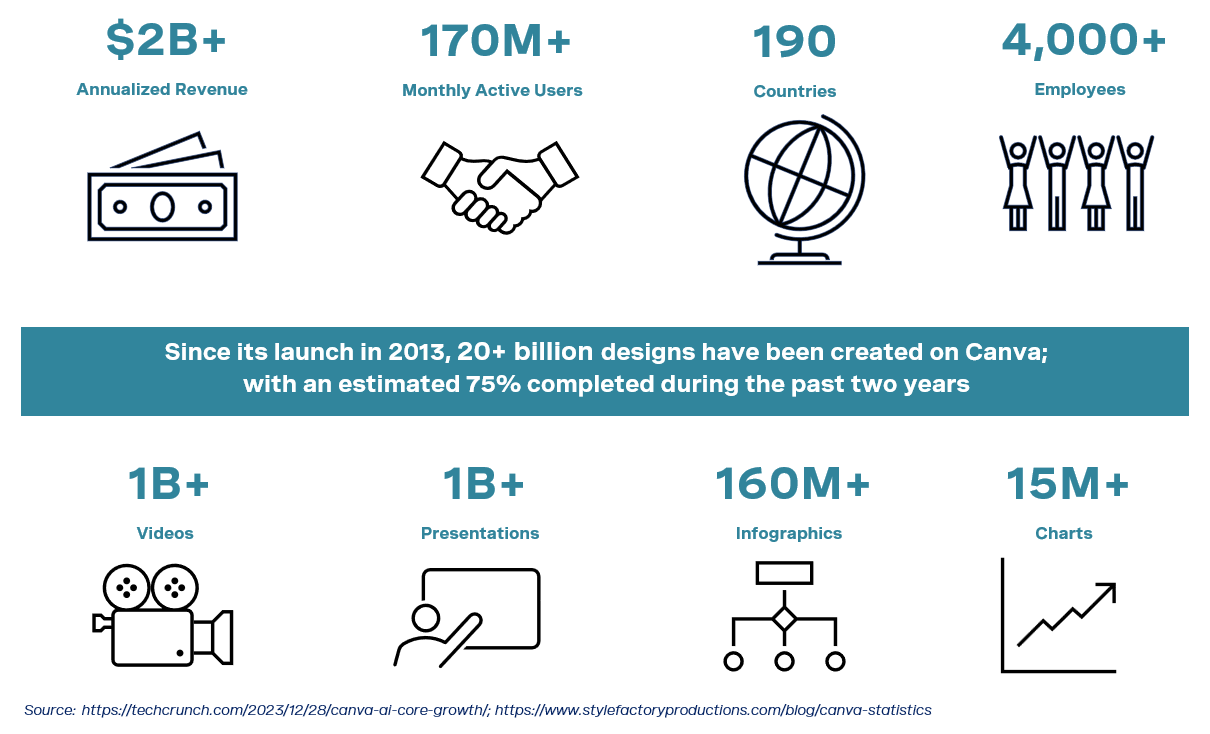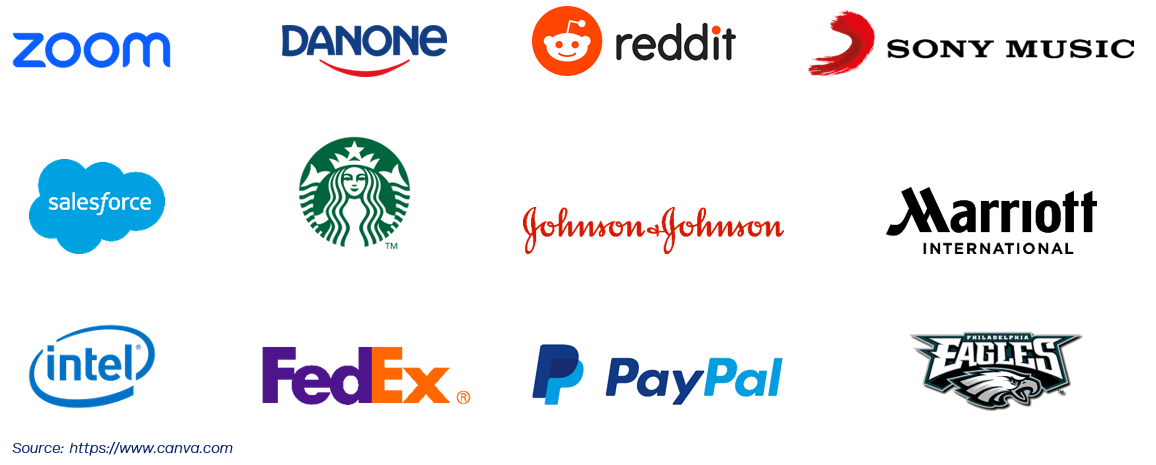
HOW CANVA HAS DIFFERENTIATED ITSELF
Canva has simplified the entire design process for its users, especially for those without any sort of design background. Its innovative and easy-to-use platform has streamlined the highly fragmented design ecosystem, bringing the functionality of applications such as Box, YouTube, Fontspace, Shutterfly, and Getty Images under one all-encompassing solution.
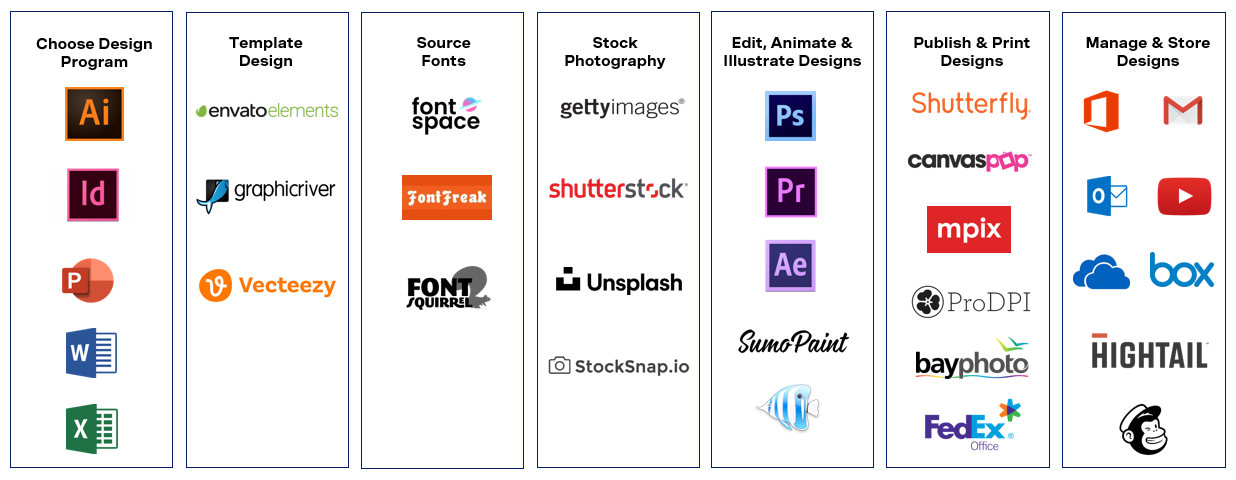
In visual terms, Canva has simplified and centralized the entire design process:

In doing so, Canva has solved several key challenges associated with graphic design and creation:
Complexity & Accessibility: traditional graphic design software (such as Adobe Creative Suite) comes with a steep learning curve; Canva overcomes this barrier through its intuitive and user-friendly platform that requires no prior design experience. Canva democratizes design, making it possible for users of all backgrounds and skill levels to generate high-quality graphic designs, presentations, and videos.
Time & Cost-Efficiency: creating designs from scratch has historically been both time-consuming and costly, particularly for individuals, small businesses, and start-ups with limited resources. Canva’s extensive library of templates and easy customization tools enables users to generate professional-grade designs quickly, saving both time and money, and enabling small businesses and start-ups to focus on growth opportunities.
Collaboration & Communication: within team-based environments, collaboration is integral to the overall design process, and traditional design software typically lack this functionality. Canva enables real-time sharing and feedback, streamlining the design process and fostering better communication among team members.
Brand Consistency: establishing a strong brand identity involves maintaining brand consistency across various marketing channels; Canva’s ‘Brand Kit’ feature helps businesses achieve consistency by centralizing brand assets such as logos, colors, fonts, and templates.
Versatility & Adaptability: businesses need to create a wide-range of visual content for various platforms and purposes in today’s fast-paced digital environment. Canva’s platform delivers a broad range of templates and tools for its users, enabling them to create everything from social media graphics, to presentations, to business cards, etc.
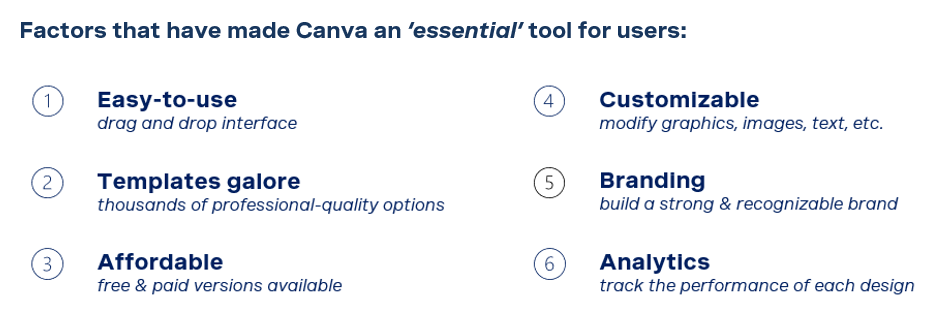
Canva's Product Offerings have been specifically designed for its various user segments:
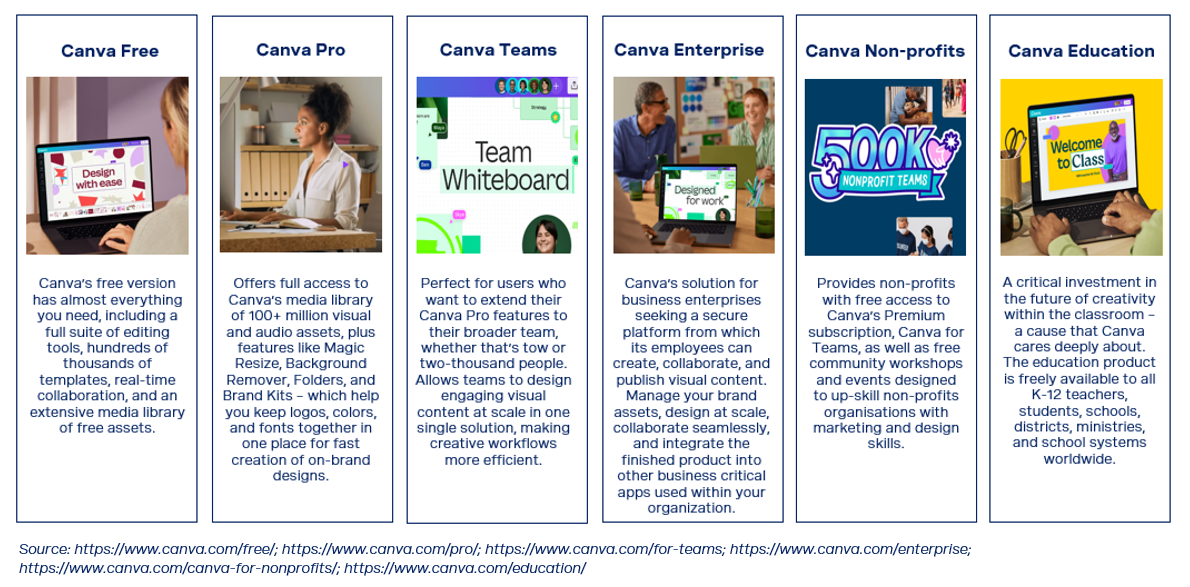
WHAT MAKES CANVA AN ATTRACTIVE INVESTMENT?
The opportunity that Canva is pursuing is significant, with the 'Creator Economy' having an estimated total addressable market (TAM) that currently exceeds US$250 billion4. The creator/design industry is experiencing rapid growth, driven by increasing demand for visually appealing content, across a number of sectors. The rise of social media marketing has only heightened the importance of content creation tools, making Canva indispensable for individuals and businesses looking to establish a strong on-line presence. By 2027, the Creator Economy is projected to have a TAM of ~US$480 billion5.
Today, roughly half of Canva’s TAM stems from the business-to-consumer (B2C) segment of the global marketplace, made up of individuals focused on social media, individual creators, students, and educators. The remaining 50% comes from the business-to-business segment of the market, comprised of teams working in areas such as Marketing, Sales, HR, Public Relations, Communications, Finance, Operations, etc. By 2028, Canva projects that the mix of its TAM will shift to a 60/40 split between the B2B and B2C segments.
Canva currently has 170M+ Monthly Active Users (MAUs), and it has done a fantastic job of attracting and engaging users to its platform by offering a ‘Freemium’ subscription option, particularly geared towards educators and students around the world. Melanie’s educational background and first-hand experience as a tutor has been instrumental in creating an economic model at Canva that gives middle school and high school students, along with their teachers, free access. Not only do students become acclimated to the Canva platform at younger ages, but they also generate updated content, which helps build Canva’s design database. The long-term bet is that as this younger demographic enters the workforce, collectively they will be much more likely to ask their respective employers for Canva Teams and/or Enterprise access to assist with their work responsibilities, representing a key growth opportunity.
Historically, Canva has been extremely successful and efficient in growing its user base with ~90% driven organically, and the other 10% coming from paid channels. Referrals, word of mouth, design sharing and collaboration, freemium access, and deep localization have all contributed to the success of its organic growth, along with the incredible features associated with the platform itself.
Clearly, B2B is a critical aspect of the future economic success of the business; that said, it is very encouraging to see that Canva is being pulled-into some of the world’s largest organizations, including 90% of Fortune 500 companies. While its recent success within the B2B segment has been strong, Canva is only beginning to scratch the surface, with less than 1% seat penetration.
CONCLUSIONOver the past decade, Canva has evolved into an incredibly successful business highlighted by its innovative and easy-to-use design platform. Transcending geographies and age groups, Canva empowers anyone to design and create, as evidenced by its diverse user base which includes individuals, students, educators, small businesses, and large enterprises worldwide.
In addition to its strong product/platform, Canva’s business fundamentals are also extremely attractive, given that its i) free cash flow positive, ii) generating annualized revenues of US$2+ billion, iii) growing aggressively, and iv) a rare example of a ‘Rule of 50’ company (YoY growth + underlying FCF margin). While its current TAM of ~US$250 billion is significant, it is projected to grow to US$480 billion by 2027. As such, Canva is well-positioned to capitalize through continued growth & adoption worldwide across both the B2C & B2B segments of its business.
If you haven’t done so already, visit
www.canva.com to create a user profile, or download the app, and experience first-hand how creative you can become with a little help from Canva!
INVESTMENT SUMMARY
Global leader in consumer & enterprise design software
• User-friendly platform has both democratized and simplified the entire digital design process
• World renowned business, with strong brand recognition:
o 170M+ monthly active users
o Across 190 countries
o Available in 100+ languages
• Continuously builds upon its market leadership via the network effect of user-generated templates, along with its newly introduced Magic Studio (gen AI tool)
Outstanding long-term growth opportunity• Operates in a large and growing global market
o Current TAM of the 'Creator Economy' is estimated at US$250+ billion; and projected to increase to US$480+ billion by 2027
• Will continue to attract new B2C customers via its ‘Freenium’ model (students, educators, and personal users)
• Objective to expand its B2B presence with Canva Teams (Fortune 100, 500, and 1000 companies)
Exceptional management team & leadership• Founder-led management team consisting of Melanie Perkins (CEO), Cliff Obrecht (COO), and Cameron Adams (CPO)
• Hands-on experience and background in graphic design & technology
• Significant ‘skin in the game’ – estimated 40%+ ownership by its management team
6• Proven leaders in product development, having capitalized on customer needs and industry trends
• Bill Tai (Stack Capital Advisor) was a seed investor and instrumental in Canva’s creation
TO ACCESS A PDF COPY OF STACK'S INVESTMENT OVERVIEW ON CANVA, PLEASE
CLICK HERE.
FOOTNOTES
1 https://techcrunch.com/2023/12/28/canva-ai-core-growth/
2 https://www.stylefactoryproductions.com/blog/canva-statistics; https://thesocialshepherd.com/blog/canva-statistics
3 https://www.canva.com/newsroom/news/canva-us-growth/; https://www.stylefactoryproductions.com/blog/canva-statistics
4 https://research.contrary.com/reports/canva
5https://research.contrary.com/reports/canva
6 https://www.forbes.com/sites/alexkonrad/2021/09/14/canva-raises-at-40-billion-valuation-and-founders-pledge-away-their-wealth/?sh=48a03d217ba9
.png)
